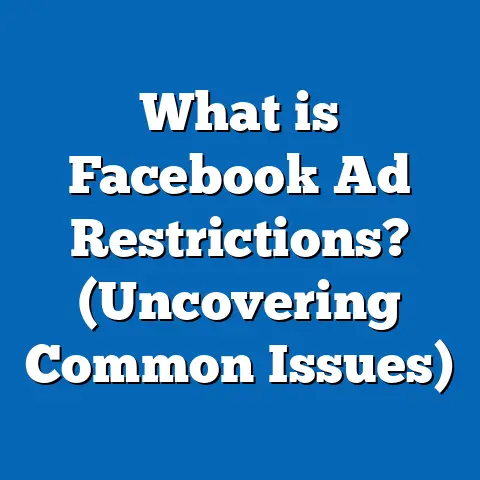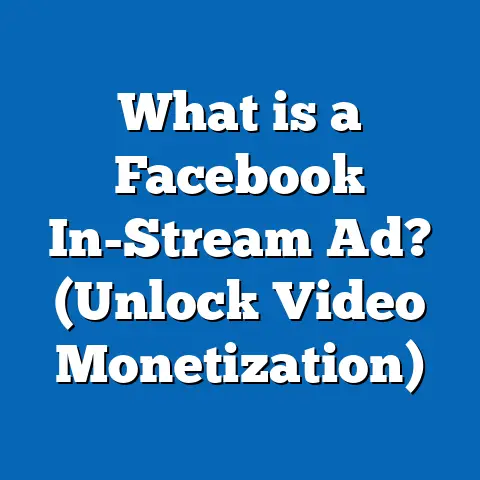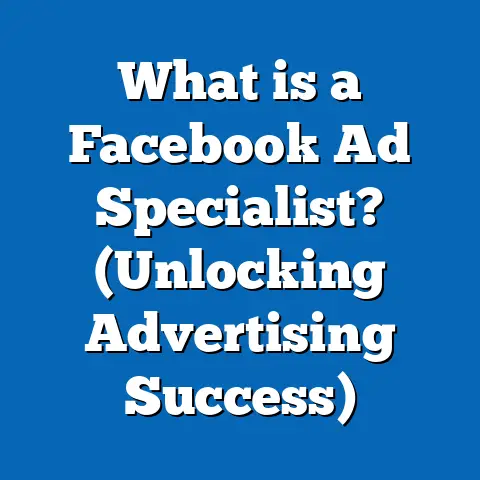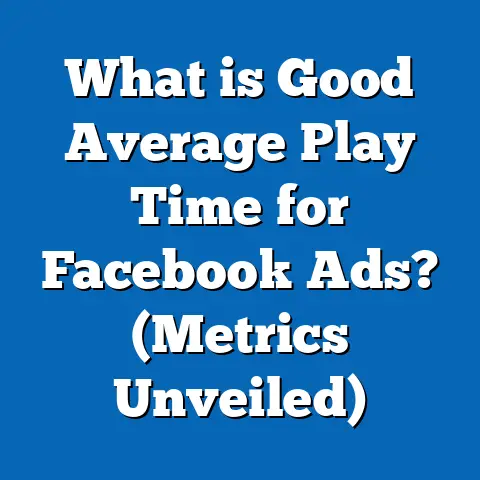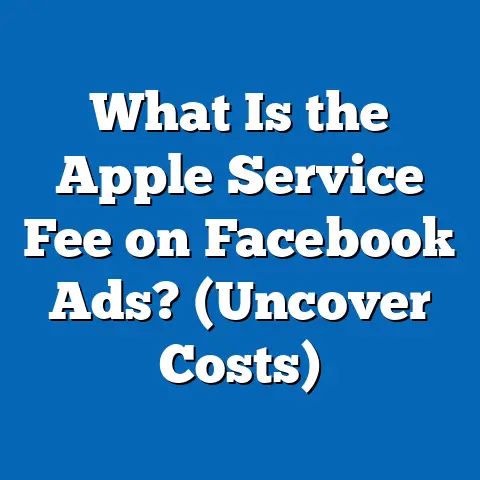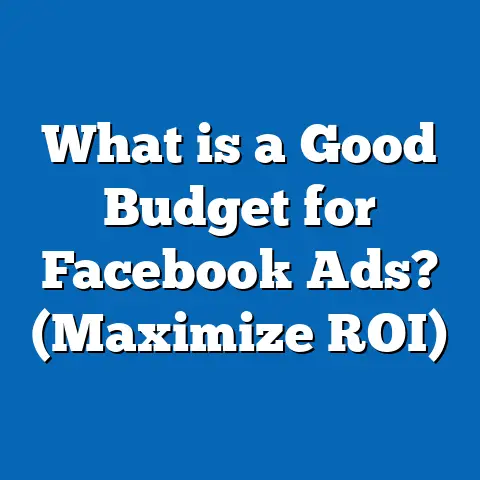What is a Brand Awareness Campaign on Facebook Ads? (Boost Visibility)
Every season brings unique shifts in consumer behavior and marketing opportunities. Whether it’s the winter holidays, spring sales, back-to-school, or summer promotions, brands must compete to capture fleeting attention. In today’s saturated digital landscape, simply having a product or service isn’t enough — businesses need to be memorable. This is where brand awareness campaigns on Facebook Ads become critical.
Facebook, with its unparalleled reach and sophisticated targeting, offers marketers a powerful tool to boost brand visibility during these crucial periods. The goal isn’t just immediate sales but building lasting recognition that fuels customer loyalty and long-term growth.
Understanding Brand Awareness: The Foundation of Marketing Success
What Exactly is Brand Awareness?
Brand awareness is how well your target audience recognizes and recalls your brand. It’s the first step in building a relationship with potential customers.
- Recognition: Can people identify your logo, name, or slogan?
- Recall: Can they remember your brand when thinking of a product category?
- Associations: What feelings or ideas come to mind when they see your brand?
Think of brand awareness as the mental availability of your brand — how easily it comes to mind.
Levels of Brand Awareness
There are different levels that represent the depth of brand familiarity:
- Unaware: The audience has never heard of your brand.
- Brand Recognition: They recognize your brand but may not know much else.
- Brand Recall: They can spontaneously name your brand when prompted about a category.
- Top-of-Mind Awareness: Your brand is the first one they think of.
Marketing campaigns aim to move users up this ladder.
Why Brands Should Invest in Awareness Campaigns
- Trust Building: Familiar brands inspire confidence.
- Market Expansion: Awareness introduces new audiences to your offerings.
- Sales Growth: Research shows consumers prefer buying from brands they know.
- Competitive Advantage: Strong awareness creates barriers for competitors.
- Long-Term ROI: Awareness sets the stage for future conversions.
According to Nielsen’s Global Trust in Advertising report (2023), 59% of consumers prefer to buy new products from brands they recognize.
The Role of Facebook Ads in Building Brand Awareness
Facebook’s Reach and Influence
Facebook remains the largest social media network globally with:
- 2.96 billion monthly active users (Statista 2024)
- Users spanning all age groups and demographics
- A vast ecosystem including Instagram, Messenger, and Audience Network
This extensive reach means businesses can put their brand in front of virtually any audience segment.
Unique Strengths for Brand Awareness Campaigns
- Advanced Targeting: Reach users based on interests, location, behaviors, demographics.
- Multiple Ad Formats: Videos, carousel ads, instant experiences, stories.
- Optimized Delivery: Facebook’s algorithm targets users most likely to remember your ad.
- Measurable Impact: Tools to track impressions, reach, engagement, and ad recall lift.
Facebook Brand Awareness Objective Explained
When creating campaigns in Facebook Ads Manager, you can choose from various objectives:
- Brand Awareness optimizes delivery to maximize estimated ad recall lift.
- This means your ad is shown to users who are more likely to remember it within two days.
- Different from “Reach” campaigns which focus on showing ads to as many people as possible without factoring recall probability.
Core Elements of a Facebook Brand Awareness Campaign
1. Audience Targeting: The Heart of Visibility
Targeting defines who sees your ads. Effective targeting balances reach with relevance.
Types of Audiences on Facebook:
- Core Audiences: Defined by demographic details (age, gender), interests (sports, fashion), and behaviors (online shopping habits).
- Custom Audiences: Retarget existing customers or website visitors using data you upload or pixel tracking.
- Lookalike Audiences: Find new prospects similar to your best customers through Facebook’s algorithmic modeling.
According to WordStream (2024), campaigns using lookalike audiences see a 70% higher conversion rate than broad targeting alone.
2. Creative Strategy: Making Your Brand Memorable
Your ad creative is what grabs attention and sticks in memory.
Visuals:
- High-resolution images or videos aligned with your brand identity.
- Use colors and styles consistent with your brand guidelines.
- Experiment with striking visuals or bold typography.
Messaging:
- Keep copy clear and concise.
- Focus on values, benefits, or unique selling propositions.
- Use emotional triggers or storytelling where appropriate.
Call-to-Action (CTA):
For awareness campaigns, soft CTAs like “Learn More,” “Watch Video,” or “Discover” encourage engagement without pushing sales immediately.
3. Ad Placements: Where Your Ads Appear
Facebook automatically places ads across:
- Facebook News Feed
- Instagram Feed & Stories
- Messenger Inbox
- Audience Network (third-party apps/websites)
You can also manually select placements based on where your audience spends time.
4. Budgeting and Bidding: Maximizing Your Spend
Set realistic budgets aligned with campaign goals:
- Use daily or lifetime budgets.
- Choose bidding strategies focused on impressions (CPM) or reach.
Industry data shows average CPMs for brand awareness campaigns range from $5 to $15 but vary by industry and targeting.
Deep Dive Into Facebook Ad Formats for Brand Awareness
Video Ads: The Most Engaging Format
Statistics from Facebook IQ (2023):
- Video ads increase ad recall by 1.5x compared to static images.
- Mobile-first video ads drive 6x higher viewer retention than desktop-focused videos.
Tips:
- Keep videos under 15 seconds for maximum impact.
- Use captions since many watch without sound.
- Start with a hook within the first 3 seconds.
Image Ads: Simple But Effective
Ideal for quick brand impressions with vibrant visuals and concise messaging.
Use carousel ads to showcase multiple products or features in one ad unit.
Stories Ads: Full-Screen Immersive Experience
Stories format offers a vertical full-screen canvas that feels native on mobile devices.
Highly effective for seasonal promotions tied closely with current events or trends.
Data-Backed Insights & Case Studies
Case Study 1: Fashion Retailer Boosts Visibility Before Holiday Season
A mid-sized fashion retailer ran a 6-week Facebook brand awareness campaign ahead of Black Friday:
- Targeted women aged 25–45 interested in fashion and lifestyle.
- Used video carousel ads highlighting new holiday collection.
Results:
| Metric | Outcome |
|---|---|
| Impressions | 10 million |
| Reach | 7.5 million |
| Estimated Ad Recall | +22% |
| Website Traffic | +30% post-campaign |
| Sales Increase | +15% next quarter |
The campaign successfully increased brand recognition that translated into measurable business growth.
Case Study 2: Tech Startup Launches New App
A startup launching a productivity app targeted young professionals using Instagram Stories and Facebook video ads optimized for recall lift.
Outcomes:
- 5 million impressions over 3 weeks
- 25% increase in branded search queries
- App downloads rose by 18% within two months post-campaign
These results demonstrate how awareness campaigns can create buzz that drives downstream conversions indirectly.
Step-by-Step Guide: Creating a Successful Facebook Brand Awareness Campaign
Step 1: Set Clear Objectives
Define what success looks like. Examples:
- Increase brand recognition by X% within Y months
- Reach Z million potential customers before product launch
- Improve ad recall lift by at least 15%
Step 2: Select “Brand Awareness” Objective in Ads Manager
This ensures Facebook optimizes delivery for recall lift rather than clicks or conversions.
Step 3: Build Your Audience
Use a mixture of Core, Custom, and Lookalike audiences based on available data and campaign goals.
Step 4: Craft Your Creative Assets
Develop multiple versions A/B tested for visuals and copy. Focus on consistency with branding.
Step 5: Set Budget and Schedule
Choose daily vs lifetime budget depending on campaign length and financial flexibility.
Step 6: Launch Campaign & Monitor KPIs
Key metrics to watch include:
- Reach
- Frequency
- CPM (Cost per thousand impressions)
- Estimated ad recall lift
- Engagement rates (likes, comments)
Step 7: Optimize Continuously
Pause low-performing ads; test new creatives; refine audience targeting based on insights.
Advanced Strategies for Maximizing Brand Recall on Facebook
Frequency Management: Avoid Overexposure
Too high frequency (>3–4 times per user) can cause ad fatigue leading to negative associations.
Use frequency caps or rotate creatives every 1–2 weeks.
Use Sequential Storytelling Ads
Deliver a series of ads that tell a story over time to build emotional connection rather than one-off impressions.
Leverage User-generated Content (UGC)
UGC builds authenticity and trust — incorporate customer testimonials or reviews in ads where possible.
Experiment with Augmented Reality (AR) Ads
AR ads engage users interactively, increasing time spent with your brand message and boosting recall rates.
Measuring Success: Metrics That Matter for Brand Awareness Campaigns
Since brand awareness is intangible compared to direct sales, rely on these key indicators:
| Metric | What It Shows | How To Track |
|---|---|---|
| Reach | Number of unique users who saw the ad | Facebook Ads Manager |
| Impressions | Total number of times ad was shown | Facebook Ads Manager |
| Frequency | Average number of times each user saw the ad | Facebook Ads Manager |
| Estimated Ad Recall Lift | Predicted % increase in people remembering ad | Provided by Facebook reporting |
| Engagement Rate | Likes, shares, comments as signals of interest | Ads Manager / Page Insights |
| Branded Search Volume | Increase in Google/Facebook searches for brand name | Google Trends / Analytics |
Comparing Facebook Brand Awareness Campaigns with Other Platforms
| Platform | Advantages | Limitations |
|---|---|---|
| Largest user base; sophisticated targeting; diverse formats | Increasing ad costs; privacy changes impact targeting accuracy | |
| Younger demographics; visual storytelling | Higher CPM; requires strong creative assets | |
| Best for B2B; professional targeting | Expensive CPM; smaller audience | |
| TikTok | Huge engagement with Gen Z; viral potential | Less mature ad platform; limited targeting options |
| YouTube | Video-heavy; good for storytelling | Higher production costs; longer attention spans needed |
Facebook remains top choice for broad consumer brand awareness due to scale and targeting flexibility.
Overcoming Common Challenges in Brand Awareness Campaigns
Challenge 1: Quantifying Impact Beyond Impressions
Use surveys (Facebook’s Brand Lift Studies), track branded search increases, monitor website traffic spikes post-campaign.
Challenge 2: Managing Ad Fatigue & Creative Burnout
Rotate creatives regularly; refresh messaging seasonally; use dynamic creative optimization tools.
Challenge 3: Balancing Reach vs Quality Targeting
Start broad but use data insights to narrow down high-performing segments for better ROI.
Future Trends Impacting Facebook Brand Awareness Campaigns
- Privacy-first Targeting: With cookie restrictions and iOS changes, first-party data and contextual targeting grow in importance.
- AI-Powered Creative Optimization: Automated tools suggest best-performing creative elements dynamically.
- Integration with Emerging Formats: Reels, Live Shopping integration provide new avenues for engagement.
- Cross-platform Synergies: Coordinated campaigns across Meta platforms improve overall impact.
- Sustainability & Social Responsibility Messaging: Brands emphasizing these values see higher engagement among younger consumers.
Practical Tips for Business Owners & Marketers
- Always define clear KPIs before launching.
- Invest in high-quality creatives aligned with your brand voice.
- Test different audience segments before scaling budgets.
- Use video content wherever possible — it drives higher recall.
- Monitor frequency closely to avoid wasting budget.
- Leverage retargeting after initial awareness phase.
- Stay updated on platform changes and new features regularly.
Summary and Next Steps
Brand awareness campaigns on Facebook Ads offer an unmatched opportunity to boost your brand’s visibility in crowded markets. By understanding key concepts like audience targeting, creative strategy, budgeting, and measurement, you can design campaigns that not only capture attention but also build lasting connections with potential customers.
Key takeaways:
- Brand awareness fuels sales indirectly by increasing familiarity and trust.
- Facebook’s unique tools make it ideal for highly targeted visibility campaigns.
- Use engaging creatives, especially video, to maximize recall.
- Monitor metrics like reach, frequency, CPM, and ad recall lift closely.
- Optimize continuously based on data insights.
Ready to launch your own campaign? Start by defining clear goals and experimenting with small budgets while refining audiences and creatives. Over time, scale up investments strategically for maximum impact.

